Update – 3/5/2015
For this article we had used Martin’s radiator testing numbers (W/10DT) for push radiators to compare with our same (W/10DT) numbers. Although the test setups were similar we found very different levels of power dissipation once we started to include push data in our own testing. So far with data from only three radiators we can see that the difference is nowhere near as drastic as we previously thought and so we are correcting this article based on the new information. Comparing at 1850RPM and 1GPM flow we have a true apples to apples (the only flow rate tested with push fans):
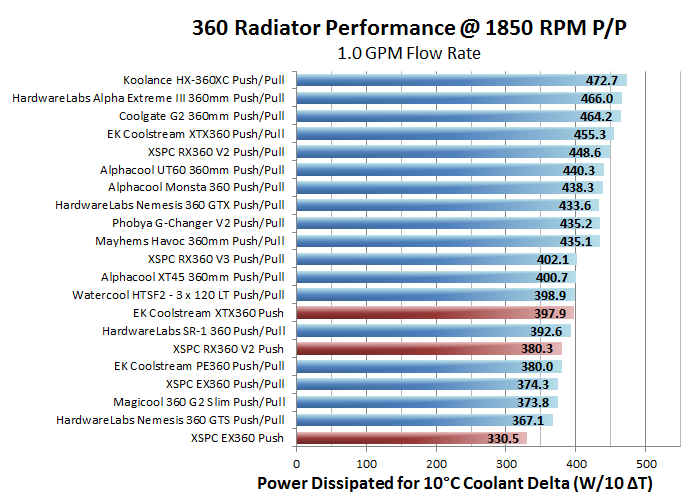
Here we can see, that a “good” radiator in push can in fact out perform a “bad” radiator in push/pull. This is contrary to our earlier claims which were based on poorly correlating data.
At 1300rpm the difference is smaller though:
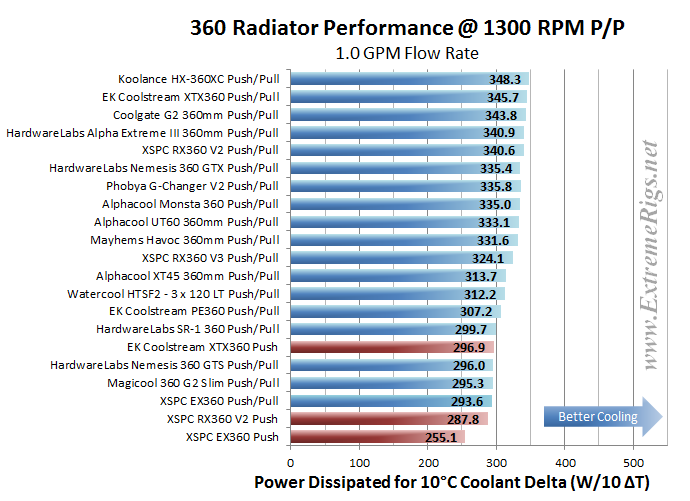
By the time 750RPM is reached it would appear that so far at least here Push/Pull does always outperform Push:
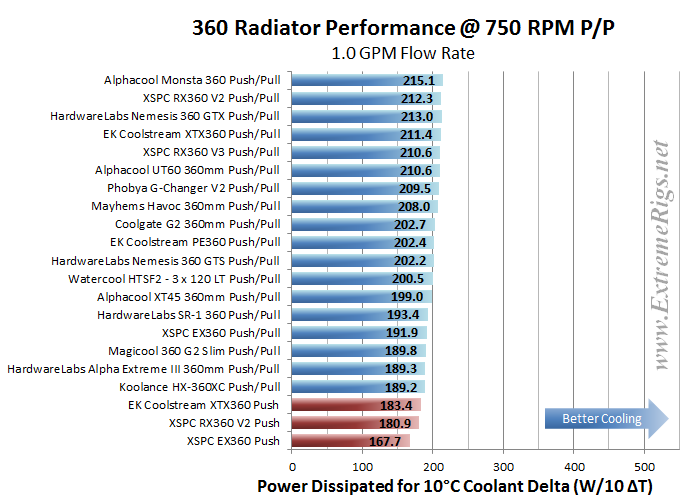 Interestingly if we look at percentage of performance for each of those three radiators data points we see that Push is between 84 and 88% of the performance of Push/Pull. This difference is small and if we were to compare the at a fixed noise level (i.e. 1600RPM Push/Pull vs 1850RPM Push) we might see a wash in terms of performance.
Interestingly if we look at percentage of performance for each of those three radiators data points we see that Push is between 84 and 88% of the performance of Push/Pull. This difference is small and if we were to compare the at a fixed noise level (i.e. 1600RPM Push/Pull vs 1850RPM Push) we might see a wash in terms of performance.
Therefore we have to back away from our earlier strong claims. Yes Push/Pull is better in performance than Push, but not necessarily when considering noise or price. More testing will of course clarify things further! The original article remains below unmolested:
/stren
Original Article
After we published the 2015 Radiator Round Up data, there was some pushback from quite a few different manufacturers claiming our use of “Push/Pull” fans was “unfair” and it favored thicker radiators. This is despite us specifically having award categories for low speed fans and for slim radiators.
Clearly manufacturers believe that the majority of users only use one set of fans. No one has statistics on the exact amount of course, but let’s assume this is true. Let us then set out to make a case for why this should be changed.
Why Push/Pull?
Before we delve into other reasons and factors to consider we must first focus on performance. Because we were able to extract W/10DeltaT numbers from fast_fate’s testing that meant we could compare results with Martin’s excellent Radiator round up from a few years back.
Note there are differences in the setup. We did not test at exactly the same fan speeds or with the same fan. Martin tested with a fixed pump power at approximately 1.5GPM while we calibrated (in these results) to 1.5GPM fixed flow rate. These numbers therefore are not precisely comparable but they are close enough for these purposes given the obvious and large differences in performance. We will update with our own “push only” numbers when we have some which should give a far more accurate comparison!
Let’s first compare high speed fans – 1850RPM Push/Pull fans on our testbench (blue) vs 1800RPM Push fans on Martin’s bench (red):
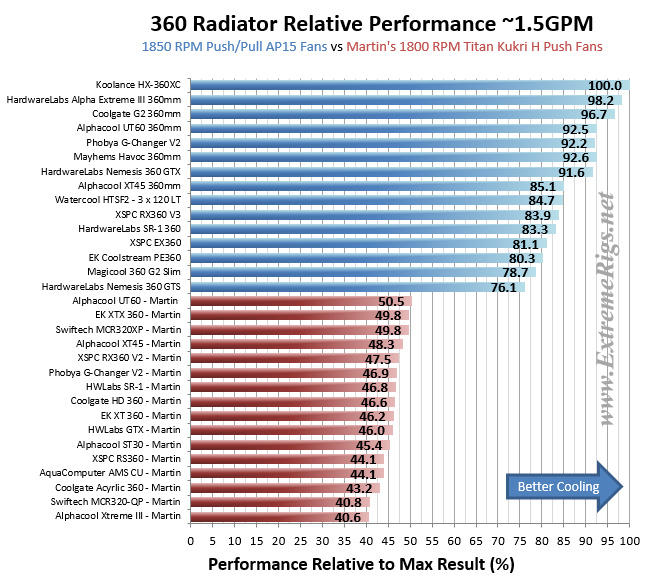
The numbers are relative performance compared to the best radiator. You’ll see there are two distinct groups – the Push/Pull radiators from 76% up, and the push only group from 40-50%
In other words ANY radiator with push/pull fans is significantly better than ANY radiator with push only fans at similar RPM.
Let’s double check that at medium fan speeds. This time 1300RPM Push/Pull vs 1400RPM Push:
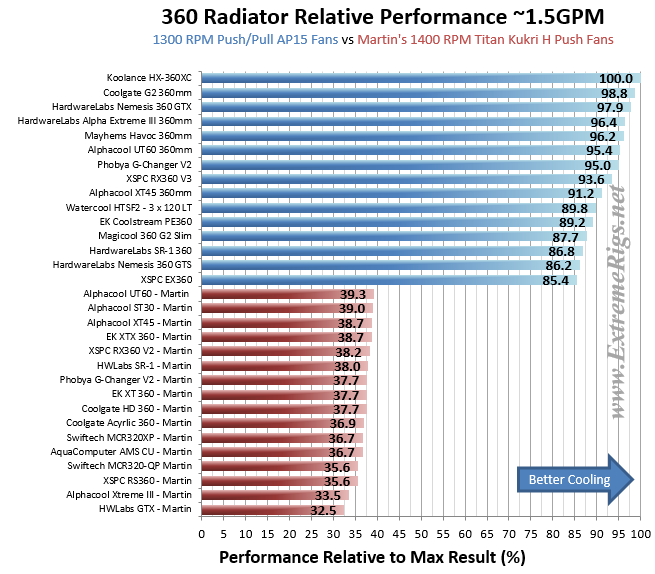
Now the performance gap is even worse! 30-40% on Push vs 85%+ on Push/Pull. The Kukri fans even have an RPM advantage here. Let’s finally compare low speed fans – 750RPM Push/Pull vs 600RPM Push:
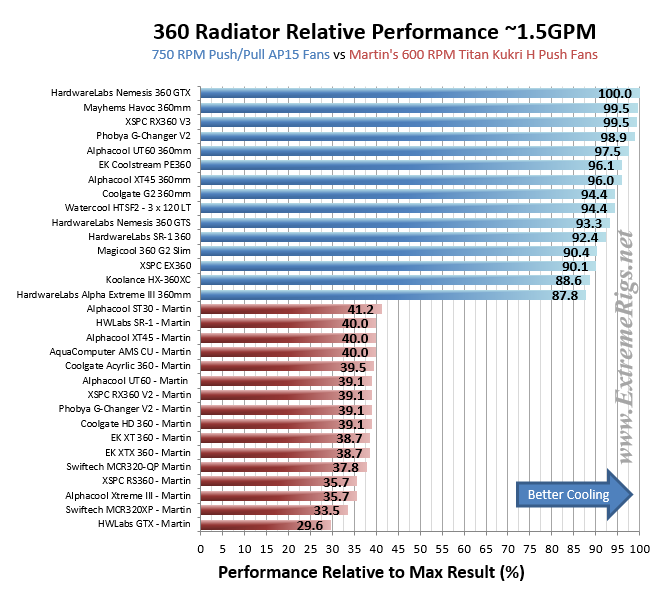
The separation is even larger.
But wait is this fair? Isn’t push/pull noisier?
Yes it is noisier – twice as many fans means that noise will increase by about a square root of 2 i.e. 3dB. For a fan at 1850RPM reducing noise by 3dB is equivalent to lowering the RPM to about 1600RPM. So let’s compare 1300RPM Push/Pull data vs 1800RPM Push data – here the 1300RPM Push/Pull fans should clearly be quieter than the 1800RPM push data, so how do they perform?
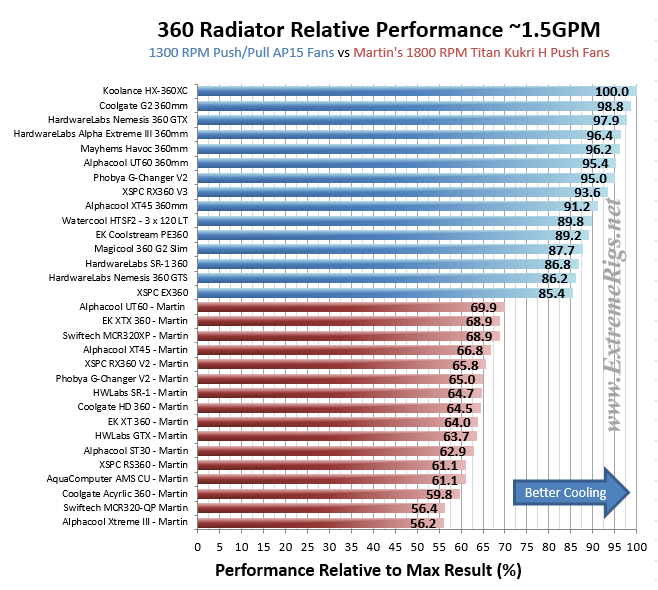
Push/Pull still comes in at 85%+, and the highest Push radiator is only at 70%.
So in other words FOR EQUIVALENT NOISE – Push/Pull on ANY radiator out performs Push on ANY radiator.
Ok so it performs better and is quieter but what about money?
Yes more fans = more money. But notice that we said ANY radiator. That means you can save money by buying the cheapest radiator possible. The Magicool G2 Slim costs $50. If you were to buy an additional three EK Vardar fans (the new AP15) to run push and pull they would cost $18 each, then the total would be $106, which is $1 cheaper than the Alphacool UT60. A “Push/Pull” radiator setup can be cheaper, higher performance and quieter than some “Push” only setups. The only exception to this of course is if you were already buying a cheap radiator for a “push” setup!
But what about the size?
Here in lies the problem – the additional fan increases the total thickness of the radiator setup by 25mm. This means that the Coolgate G2 that was our overall winner becomes an astonishing 115mm thick. However remember that we said that ANY radiator in push/pull beats out a push setup. The thinnest radiator that we tested was 30mm thick. Adding on 50mm of fans means that’s a total of 80mm. This means that it is acceptable to run one set of fans IF you have less clearance than 80mm. But of course if you have less clearance than 80mm then the thickest radiator you can ever consider is 80mm-25mm = 55mm. So that rules out any of our radiators in the review classed as “thick” anyway.
So in conclusion
– Push/Pull is quieter for the same performance
– Push/Pull performs better for the same fan speed
– Push/Pull can perform just as well in the same total space (in tight spaces though you will still be limited to push only)
– Push/Pull can (but not always) perform better for less $$$
If you are currently running one set of fans then you will get real value by adding some more. If you’re building a system then it’s worth making push/pull work even if it means getting a slimmer radiator.
So when a manufacturer complains to me that our testing is unfair because their radiator is designed for performance with only set of fans I’m confused. This is because as we’ve seen that “performance” and “one set of fans” are really mutually exclusive. As soon as you are using only one set of fans you’ve decided to give up on performance. In other words that person should be choosing the radiator based on other more important factors e.g. cost or space. As we are reviewing *performance* then we test with *performance* in mind. Now this may make a few people unhappy who didn’t approach their radiator design with this in mind, but this is the logical conclusion from the information that we have. Some will then say that people don’t run push/pull setups so therefore that they don’t cater to them, but this is silly. Not only are there not statistics on what users really do but if that were the case the manufacturer could easily educate people on this (particularly those that offer fans for sale too). The aim of this article is to educate people and hopefully as a result we get better performing radiators optimized for push/pull in the future. Perhaps we will even see a super slim design to give the benefits of push/pull in tighter spaces.








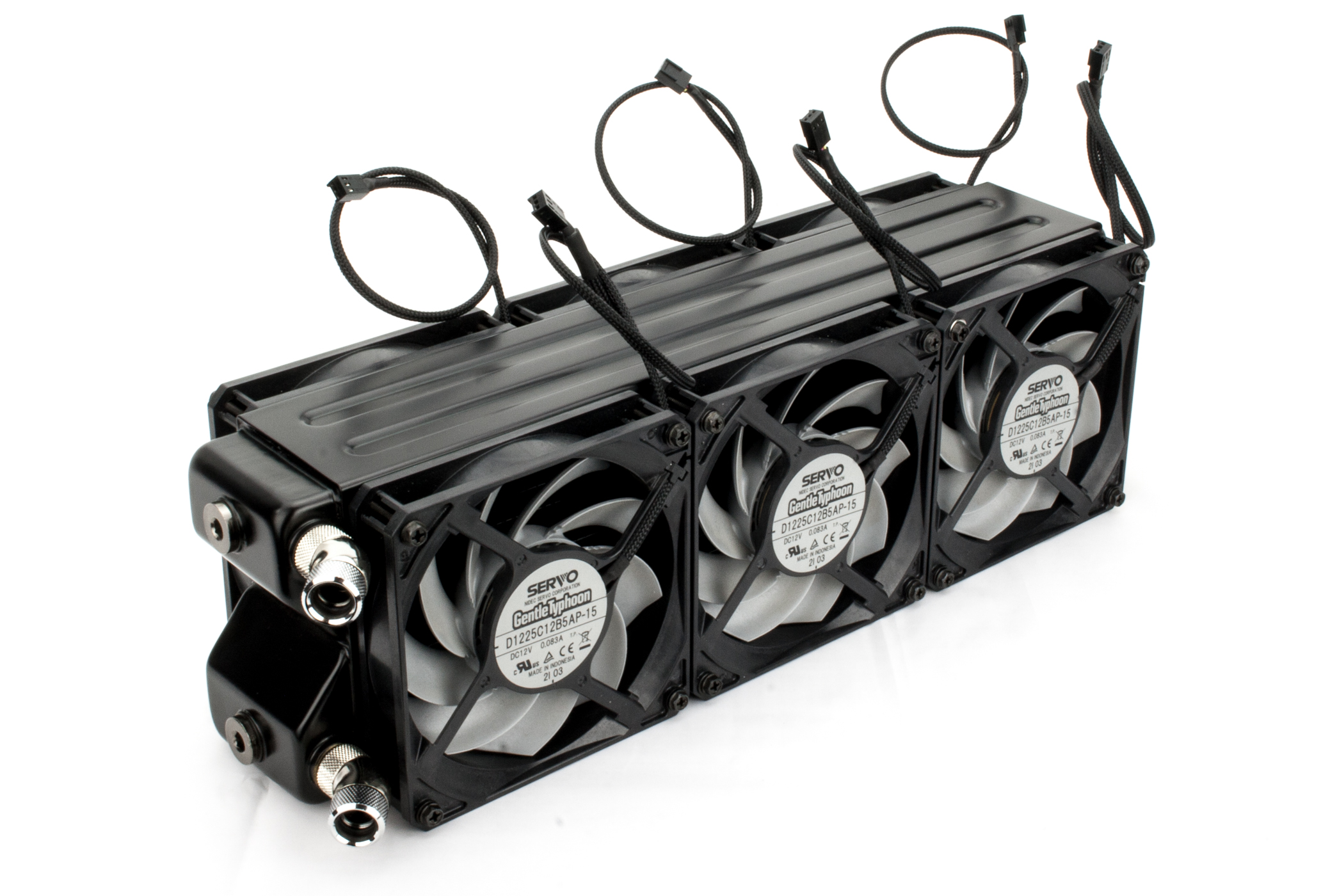




[…] Push/Pull Radiator Setups or “How I learned to stop worrying and love that more fans = less no… […]
Yup!
Push/pull all the way.
And that even if you have to go down in radiator thickness until you can fit p/p.
If you don’t use the same type of fans Push vs. PushPull you are comparing apples and oranges.
Unless you also present data that supports the two type of fans being very similar concerning noise, airflow and static pressure.
Agreed – The Titans at 2100RPM are about equivalent to 1850RPM AP15s if you look at CFM through a rad – link here: https://martinsliquidlab.wordpress.com/2012/04/28/r9-fan-testing-gentle-typhoon-ap-29/
To be honest I think the bigger difference is in the general testbench setup itself. Even though they are so similar I now think that they are still too different to compare directly. For that reason we’ll be replacing Martin’s data on Push with our own shortly
The updated info looks much better. 20ish% improvements instead of 100% gels much better with what I have seen. 100% would make an extra set of fans the equivalent of another radiator.
Never compensate for anything when it comes to your build……shoot I got a bigger case so that I didn’t have to worry about space.
Like I mentioned in my prior two posts, I want to thank you for this extensive and extremely detailed review (and even this update). This is definitely an updated version to SkinneeLabs.com’s rad reviews and Martinliquidlab’s review on radiators (found here: https://martinsliquidlab.wordpress.com/category/radiators/). I was debating (as I’m a reseller for Koolance), weather or not to purchase the Koolance HX-360XC product or the Coolgate CG-360G2. As a result of your thorough testing I’m going to go with the Coolgate CG-360G2. I know you mentioned that it’s hard enough to put just one of these bad boys in your CaseLabs PC Case, but I’m going to put TWO of them in. DESPITE what Martin’s tests results were when it came to “sandwiching,” my config will be set up like this:
25mm Fan/65mm Rad/25mm Fan/65mm Rad/25mm Fan = 205mm total width (sandwiching 3 fans together side by side by side and using 2 thick wide-finned rads in-between)
Which will just cover the bottom of the width of my Origin Genesis PC Case. I’ll post the results later in a couple of months once I’m finished with my (hopeful) new Hackintosh build. We’ll see what happens. I believe that the results of the setup that I will be using will be just fine. If you believe otherwise please let me know. Again, thank you for your help. Greatly appreciated !!!
Comments are closed.